As U.S. law enforcement officers act as key responders against the COVID-19 pandemic, Vanda Felbab-Brown outlines key areas for policing units to set their focus in the short- and medium-terms. This piece was originally published by Lawfare.
Police and law enforcement officers are on the frontline of the coronavirus response. Both policing and crime have been deeply affected by the virus and will be shaped by the pandemic for a long time to come, though some effects will be more profound and lasting than others. In a forthcoming May 28 piece—part of a Brookings series on how on the United States should reopen various parts of the economy, public life and external engagement after the initial lockdown—I reflect on immediate, coronavirus-specific challenges and priorities for domestic law enforcement—including how to reinforce and prepare police forces, what kind of unrest to expect when new lockdowns become necessary, how to deal with prisons and how to respond to domestic violence. In this piece, I will analyze other short-term and medium-term policing priorities as well as law enforcement distractions.
Reinforce Reductions in Gang Violence and Emphasize Police Responsiveness
Around the world as well as in various parts of the U.S., the coronavirus lockdown disrupted local patterns of street crime; predatory crime, such as mugging and robberies, decreased dramatically as potential victims did not mingle on the streets. After this initial drop, however, burglaries of closed storefronts and car theft increased. As the country reopens, these two patterns may change again; with more potential victims on the street, muggings and pickpocketing may rise again and burglaries of better guarded stores, along with car theft, could decrease.
The question is what will happen to homicides in the U.S., and here the coronavirus disruption provides a unique opportunity. Homicides have been declining in the United States over the past two decades—except for difficult pockets of persisting high violence, such as in Chicago and Baltimore.
But the coronavirus disrupted—at least temporarily—this entrenched violence that has been resistant to numerous policy interventions. During the coronavirus lockdowns, gang violence driven by tit-for-tat honor killings and fights over local retail drug markets declined dramatically at first, including in places where numerous policing strategies failed to reduce gang violence—such as Chicago or El Salvador. In contrast, premeditated strategic warfare among organized crime groups did not, for the most part, decrease during the worldwide lockdowns; in Mexico, in March and April, homicides continued to break monthly records and significantly surpass official, if suspect, counts of Mexico’s COVID-19 deaths. Unfortunately, the immediate reduction in violence early on in the lockdown is already being lost: By the end of April, Chicago saw 15 percent more gun violence than in the same period last year.
Reinforcing the reduction in gang violence in U.S. cities should be a priority for law enforcement forces as well as civil society, even during the pandemic. One strategy to deploy is a focused deterrence approach. Backed by influential actors in civil society—such as religious authorities, community leaders and mothers—law enforcement representatives should engage with gang leaders, indicating to them that the current violence disruption presents an opportunity to avoid lengthy imprisonment for gang members while being clear that homicides and violent assault will be prosecuted with determination. The drop in homicides allows investigators and prosecutors the opportunity to resolve a greater number of new homicides and obtain guilty verdicts, thus boosting not just the effective prosecution rate but also deterrence effects. Powerful and consistent evidence shows that it is the prevalence of effective prosecution far more so than the severity of penalty that deters crime. A former U.S. deputy attorney general once assessed in a conversation with me that in his experience in the United States, South Africa, Colombia and Guatemala, creating deterrence effects for homicides requires an effective prosecution rate of some 40 percent. Intervention strategies to keep gang violence down also include maintaining and expanding behavioral therapy and counseling—including via virtual platforms—to gang members to dissuade them from rash, violent retaliations for perceived dishonor. As the coronavirus wiped out many of the jobs that can be presented to gang members as reasons and opportunities to disengage from violence, reinforcing online behavioral therapy approaches and teaching skill sets in problem solving and conflict resolution can be all the more important.
Such a focus is all the more urgent as gang violence is likely to increase, in part because finances of gang members—like those of most Americans—will be depleted and street crime, such as drug dealing, may be driven by food insecurity. Already, some U.S. localities have experienced a rise in shooting, including fatal attacks, over local drug retail markets. In addition to an important focus on well-tested and effective problem-oriented policing, responses for avoiding a renewed rise in violence may include engagement with local community leaders to organize food banks and to discourage street violence and retaliation.
Do Not Waste Police Resources on Targeting Undocumented Migrants
The Trump administration has spent its entire tenure hunting for undocumented migrants and threatening to penalize police departments that refused to aggressively participate in such a misguided policing focus, setting off ongoing complex litigation as to when the federal government can withhold money from police departments in sanctuary cities. The administration has ignored warnings from police chiefs of many major U.S. cities that such a policing approach is counterproductive.
Pressuring local police forces to check immigration papers of residents and obligating them to prioritize hunting undocumented individuals will ultimately hurt law enforcement. The George W. Bush administration tried that policy; it did not helpreduce crime, and local police departments resented it and found it counterproductive, diverting them from other anti-crime priorities and alienating local communities. Communities in fear, including those with legal immigration status but whose relatives are undocumented, shut down and refuse to interact with police forces; the sense of alienation grows; and protests against police can escalate—in the process, vital information on serious crime can be lost.
It is not just a matter of undocumented workers being afraid to cooperate with the police in addressing violent crime. Entire communities, including U.S. citizens and legal residents, might turn away from the police. In order to identify and stop criminals, the police need to know and be accepted by the community.
All of these imperatives are amplified by the coronavirus. The illness can persist among populations—such as undocumented migrants fearing arrest—who do not have access to health care but who must work because they have no livelihood reserves. Although the Trump administration is poised to pressure police departments to track down undocumented migrants, this is not an effective use of police resources. Among all the complex issues that exhausted police departments will need to deal with during reopening, hunting down undocumented migrants is not only the least important—it is directly counterproductive to the facilitation of healthy recovery by U.S. communities and the minimization of coronavirus outbreaks. No community should fear seeking health care if the progress of the disease makes isolation at home inadequate. Pushing any community into the shadows by bad policies risks reinfecting much larger communities. Not only is targeting undocumented populations unnecessary right now, but the Trump administration should worry that it will cause an extended lockdown period and increased spread of the pandemic.
Meanwhile, detention of undocumented residents by Immigration and Customs Enforcement (ICE) has already set off the extensive spread of the virus in detention centers. Even after a federal judge ruled that 22 people at high risk for COVID-19 should be released from immigration detention in Pennsylvania jails, ICE transferredsome undocumented detainees from those same jails to other jurisdictions. Such a policy places detainees in danger—even after judges have affirmed the health risks posed by immigration detention centers in the midst of the pandemic—and could spread the infection around the country, including to workers at those centers. As of May 9, 27,908 immigrants were being held, and 965 cases of COVID-19 were confirmed in these centers, even though testing of detainees was vastly inadequate. The data is poor, but even with those likely significant undercounts, the 1.2 percent infection rate among detainees is almost three times as high as among the U.S. population overall. Many have become infected in detention, where health facilities are disastrously insufficient, particularly for those who have COVID-19. Worse yet, the Trump administration has been deporting infected migrants abroad, failing in the basic humanitarian obligation to garner medical help for the infirm—and leaving struggling, vulnerable and unprepared governments and communities in Mexico, Central America and the Caribbean scrambling to respond. Previously, U.S. deportation policies spread dangerous gang violence to Central America; now the Trump administration is spreading infection.
Overall, the Trump administration has exploited the coronavirus to discharge several salvos of anti-immigrant policies so as to minimize even legal immigration. Indifferent to how the policies also hurt U.S. citizens, such as the spouses and children of the undocumented, the administration is preparing further policies to prevent migration to the United States and remove immigrants. Nor does the administration recognize that many of the undocumented are employed to nurse the elderly, or work in U.S. agriculture and slaughterhouses. In the U.S. health care industry, 16 percent of workers are foreign born. The U.S. food processing industry employs 3.8 million immigrants—though not all are undocumented. And nearly 28 percent of the country’s agricultural workers are foreign born. They provide essential help in avoiding food shortages and reducing the crisis in the U.S. health care sector, even as they risk their lives to infection by having to work in close proximity with others without taking the proper precautions. Few of the U.S. citizens who have lost their jobs due to the coronavirus will seek out these back-breaking and dangerous jobs. As U.S. agribusinesses protested the anti-immigrant fervor of the Trump administration—even against those who hold temporary visas—the Trump administration eased regulations for H-2A agricultural visas. But as the U.S. presidential election approaches, the Trump administration continues to beat a vicious and counterproductive anti-immigration drum, at the worst possible moment during a crisis that requires the help of undocumented frontline workers.
Target Right-Wing, Neo-Nazi Groups and U.S. Militia Groups That Incite Violence
Far-right groups in the U.S. and some anti-immigrant, anti-federal-government and survivalist U.S. militias who envision a coming civil war in the U.S. have seized on the economic desperation and dislocation of the pandemic to advance their dangerous and sometimes outright violent agendas. To a large extent mimicking the coronavirus rhetoric of violent jihadists, far-right extremists in the U.S. have moved beyond calling the coronavirus a hoax to falsely claiming that the pandemic was purposefully arranged by China or Jews. They have scapegoated immigrants, African Americans, law enforcement officials and Democratic Party politicians. Online, they have called for spreading the virus to Jewish people, by getting themselves infected and hanging around synagogues. They have urged sabotaging infrastructure to provoke race riots. They have even gone so far as to urge their followers to spray bullets on city streets and into car windows to promote panic, chaos and social strife. Seeking a total collapse of governance, they have posted formulas for citizens to make their own bombs and toxic gases.
Distressingly, their potent propaganda during the lockdown has generated a significant uptick in online traffic on their social media platforms and in response to their recruitment appeals, though it is not yet clear how large an increase in membership this has produced.
Much of this far-right and militia subculture lives in an expectation of a second civil war, as I mentioned earlier, often coded as “the boogaloo” or race war in the United States—and much of their activity seeks to accelerate its envisioned arrival. At least 125 boogaloo-promoting groups were identified on Facebook by mid-April, with 60 percent of them created in just the past three months and a combined online membership of 73,000—though it is not clear how many members belong to multiple groups. A YouTube video with 340,000 views—called “Top 5 Boogaloo Guns”—preaches the need to “take to the streets and take care of business” against a “tyrannical government” in the United States.
The right to carry weapons is a common theme among such extremist and U.S. militia groups, and some gun shop owners and pro-gun activists have been catering to these groups, cultivating them and supplying them with propaganda. Alarmingly, gun sales in the U.S. experienced their greatest spike in the first month of the lockdown, rising by 85 percent compared to March 2019.
Far-right groups and militias, such as the Michigan Liberty Militia, have sought to intimidate government officials into prematurely calling off lockdowns—including the recent case in Michigan when they stormed the state house to threaten Democratic Governor Gretchen Whitmer. Although they claim to have a right to carry weapons to demonstrate their Second Amendment rights, clearly their purpose is to intimidate those who disagree with them.
Increasingly, individual militias as well as entire militia groups have moved to forcefully assist in the reopening of stores and businesses in defiance of local ordinances. In doing so, they are intimidating not just local authorities and elected government officials, but also law enforcement officials who are needed to counter their activities. More than through other mechanisms, the militias have been able to use their declared support for protecting law-violating businesses to build up political capital with a wide set of conservative actors—not just gun stores and right-wing politicians, but also ordinary conservative citizens. Being able to deliver services to a broader segment of the population—that is, enabling disgruntled business owners no longer willing to comply with lockdowns to open their businesses—allows the militia groups to transform themselves from limited fringe entities catering mostly to their members into groups with political capital among a much wider segment of the public. A buildup of broader popular support may shield them from law enforcement actions as local politicians or government officials refuse to authorize law enforcement actions against them or act against their intimidation. This political capital derived from protecting and encouraging law violations through intimidation is a threat to the rule of law in the United States.
Some individuals affiliated with these far-right groups have moved beyond intimidation and the incitement of violence to the attempt to carry out violence. In Missouri, Navy veteran Timothy Wilson—who frequented far-right webpages and had been the subject of a months-long FBI investigation—attempted to blow up a hospital treating COVID-19 patients by using a vehicle laden with explosives, but he was intercepted and killed by FBI agents. Online, he claimed that the federal government sought to use the pandemic as “an excuse to destroy our people,” in what he called “a Jewish power grab.” In Arkansas, Aaron Swenson—who frequented boogaloo Facebook pages—announced on April 12 that he was hunting for a law enforcement officer to kill and was ultimately arrested by the Texarkana police.
Law enforcement officials so far have been successful in disrupting these violent planned crimes. They must place the highest priority on prosecuting any efforts to intimidate or target law enforcement officials. They need to remain vigilant against the possibility of more violent attacks by far-right groups and militias and must anticipate that more violent recruitment and incitement, as well as actual attempts, will follow—particularly if a second lockdown locally or nationally becomes necessary.
The big increase in recruitment by far-right groups and militias provides an opportunity for local and state police forces as well as federal law enforcement agencies to infiltrate the groups and build up networks of informants. Social media platforms of groups that call for violence need to be shut down diligently. At the same time, U.S. law enforcement officials should mount sting operations and conspiracy-charge-based prosecutions that have been highly effective in preventing and disrupting jihadi terrorist attacks in the United States and leading to the apprehension and effective prosecution of criminals with global notoriety, such as Viktor Bout. Adopting focused deterrence strategies, law enforcement officers should also build up portfolios of prosecutable crimes against far-right and militia leaders—particularly violent members—both to indict them and to deter other members from crossing into illegality and violent action.
The rise of such violent political militancy in the United States poses an even greater danger to public safety and the quality of democracy than most criminal groups could ever mount.
Conclusion
U.S. law enforcement forces are key responders against the coronavirus pandemic, often toiling under difficult circumstances to preserve public safety. Many improvements in U.S. policing that long preceded the pandemic—including regarding racial fairness—remain urgent and imperative. While the pandemic creates new challenges for policing and exacerbates others, the hardships related to the coronavirus also present new opportunities for strengthening citizens’ safety and improving relations between communities and law enforcement. Reducing gang violence and strengthening the safety of minority and marginalized communities is one important facet; resolutely acting against far-right groups and militias that promote violence and work to undermine the rule of law and law enforcement forces is another.
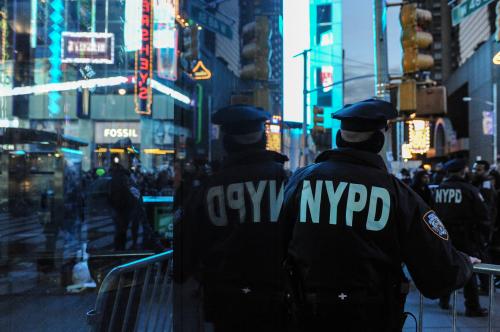
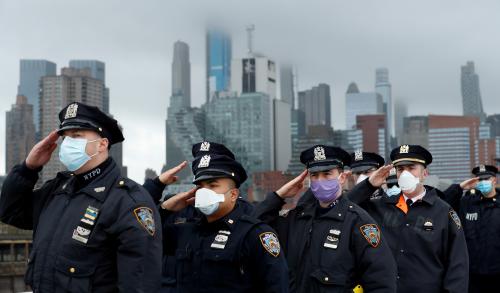
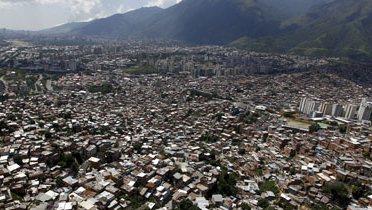
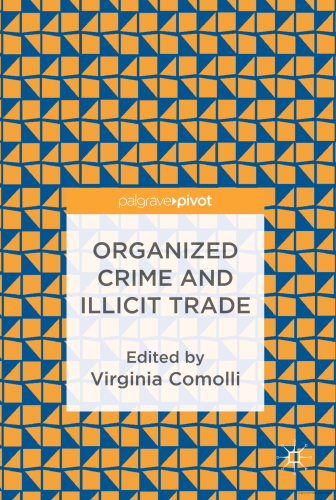
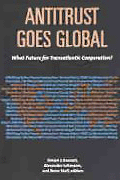
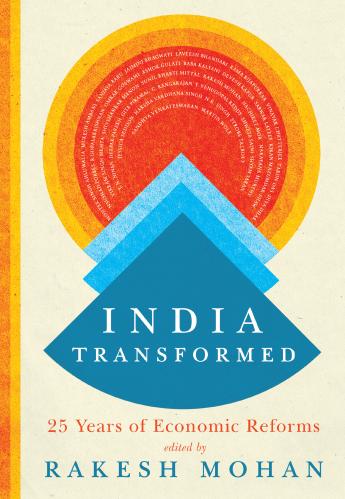



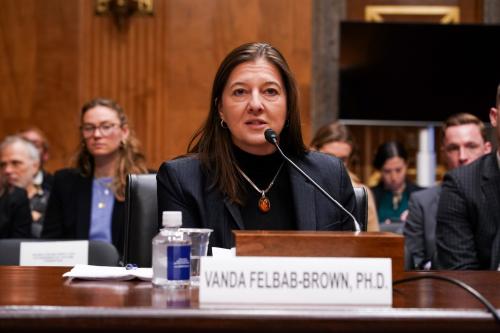
Commentary
Op-edUS policing after wave one of COVID-19
May 20, 2020